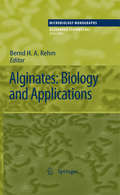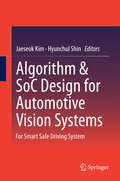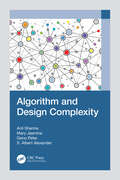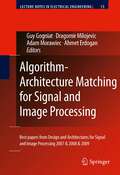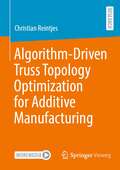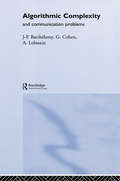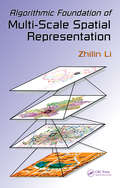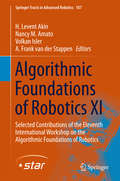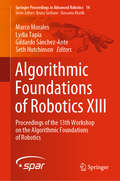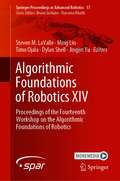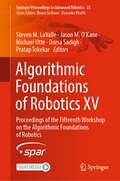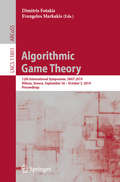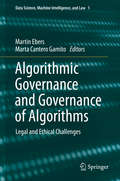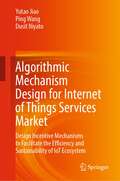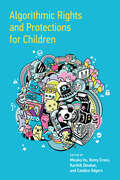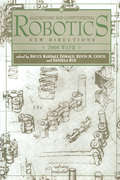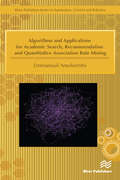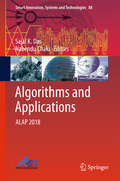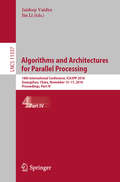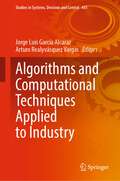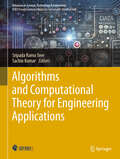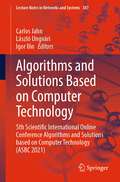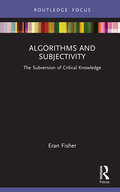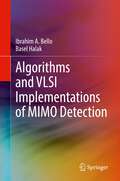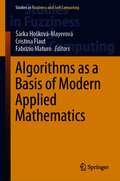- Table View
- List View
Alginates: Biology And Applications (Microbiology Monographs #13)
by Bernd H. Rehm"Alginates: Biology and Applications" provides an overview of the state of art of alginate material properties, genetics and the molecular mechanisms underlying alginate biosynthesis as well as applications of tailor-made alginates in medicine, food and biotechnology. Topics treated are: material properties of alginates, alginate production: precursor biosynthesis, polymerization and secretion, bacterial system for alginate uptake and degradation, enzymatic alginate modification, alginate gene regulation, role of alginate in bacterial biofilms, microbial production of alginates: physiology and process aspects, alginate-based blends and nano/microbeads, applications of alginates in food, alginate and its comonomer mannuronic acid: medical relevance as drugs.
Algorithm & SoC Design for Automotive Vision Systems: For Smart Safe Driving System
by Jaeseok Kim Hyunchul ShinAn emerging trend in the automobile industry is its convergence with information technology (IT). Indeed, it has been estimated that almost 90% of new automobile technologies involve IT in some form. Smart driving technologies that improve safety as well as green fuel technologies are quite representative of the convergence between IT and automobiles. The smart driving technologies include three key elements: sensing of driving environments, detection of objects and potential hazards and the generation of driving control signals including warning signals. Although radar-based systems are primarily used for sensing the driving environments, the camera has gained importance in advanced driver assistance systems (ADAS). This book covers system-on-a-chip (SoC) designs--including both algorithms and hardware--related with image sensing and object detection by using the camera for smart driving systems. It introduces a variety of algorithms such as lens correction, super resolution, image enhancement and object detections from the images captured by low-cost vehicle camera. This is followed by implementation issues such as SoC architecture, hardware accelerator, software development environment and reliability techniques for automobile vision systems. This book is aimed for the new and practicing engineers in automotive and chip-design industries to provide some overall guidelines for the development of automotive vision systems. It will also help graduate students understand and get started for the research work in this field.
Algorithm and Design Complexity
by S. Albert Alexander Anli Sherine Mary Jasmine Geno PeterComputational complexity is critical in analysis of algorithms and is important to be able to select algorithms for efficiency and solvability. Algorithm and Design Complexity initiates with discussion of algorithm analysis, time-space trade-off, symptotic notations, and so forth. It further includes algorithms that are definite and effective, known as computational procedures. Further topics explored include divide-and-conquer, dynamic programming, and backtracking. Features: Includes complete coverage of basics and design of algorithms Discusses algorithm analysis techniques like divide-and-conquer, dynamic programming, and greedy heuristics Provides time and space complexity tutorials Reviews combinatorial optimization of Knapsack problem Simplifies recurrence relation for time complexity This book is aimed at graduate students and researchers in computers science, information technology, and electrical engineering.
Algorithm-Architecture Matching for Signal and Image Processing: Best papers from Design and Architectures for Signal and Image Processing 2007 & 2008 & 2009 (Lecture Notes in Electrical Engineering #73)
by Adam Morawiec Guy Gogniat Dragomir Milojevic Ahmet ErdoganAdvances in signal and image processing together with increasing computing power are bringing mobile technology closer to applications in a variety of domains like automotive, health, telecommunication, multimedia, entertainment and many others. The development of these leading applications, involving a large diversity of algorithms (e.g. signal, image, video, 3D, communication, cryptography) is classically divided into three consecutive steps: a theoretical study of the algorithms, a study of the target architecture, and finally the implementation. Such a linear design flow is reaching its limits due to intense pressure on design cycle and strict performance constraints. The approach, called Algorithm-Architecture Matching, aims to leverage design flows with a simultaneous study of both algorithmic and architectural issues, taking into account multiple design constraints, as well as algorithm and architecture optimizations, that couldn't be achieved otherwise if considered separately. Introducing new design methodologies is mandatory when facing the new emerging applications as for example advanced mobile communication or graphics using sub-micron manufacturing technologies or 3D-Integrated Circuits. This diversity forms a driving force for the future evolutions of embedded system designs methodologies. The main expectations from system designers' point of view are related to methods, tools and architectures supporting application complexity and design cycle reduction. Advanced optimizations are essential to meet design constraints and to enable a wide acceptance of these new technologies. Algorithm-Architecture Matching for Signal and Image Processing presents a collection of selected contributions from both industry and academia, addressing different aspects of Algorithm-Architecture Matching approach ranging from sensors to architectures design. The scope of this book reflects the diversity of potential algorithms, including signal, communication, image, video, 3D-Graphics implemented onto various architectures from FPGA to multiprocessor systems. Several synthesis and resource management techniques leveraging design optimizations are also described and applied to numerous algorithms. Algorithm-Architecture Matching for Signal and Image Processing should be on each designer's and EDA tool developer's shelf, as well as on those with an interest in digital system design optimizations dealing with advanced algorithms.
Algorithm-Driven Truss Topology Optimization for Additive Manufacturing
by Christian ReintjesSince Additive Manufacturing (AM) techniques allow the manufacture of complex-shaped structures the combination of lightweight construction, topology optimization, and AM is of significant interest. Besides the established continuum topology optimization methods, less attention is paid to algorithm-driven optimization based on linear optimization, which can also be used for topology optimization of truss-like structures.To overcome this shortcoming, we combined linear optimization, Computer-Aided Design (CAD), numerical shape optimization, and numerical simulation into an algorithm-driven product design process for additively manufactured truss-like structures. With our Ansys SpaceClaim add-in construcTOR, which is capable of obtaining ready-for-machine-interpretation CAD data of truss-like structures out of raw mathematical optimization data, the high performance of (heuristic-based) optimization algorithms implemented in linear programming software is now available to the CAD community.
Algorithmic Complexity and Telecommunication Problems
by J-P Barthelmy G. Cohen A LobsteinIn this treatment of algorithmic complexity the authors explore an area fundamental to the study of the foundations of computer science. It is a topic which is at the interface of information theory, applied mathematics and computer language theory and which is rooted strongly in this book in the problems of computer communication.; Complexity theory classifies problems according to the difficulty of resolving them, while algorithms provide the computational method for solving those problems. Therefore, algorithmic complexity is concerned with establishing the best algorithm given the constraints of the computational environment and the degree of complexity.; The first three chapters present the context for a later in-depth look at applied areas of the subject, with an outline of classical complexity theory. This is followed by three chapters which explore the key area of information communication. Within this field, the book is particularly concerned with two contiguous areas which make contrasting demands on the application of algorithmic complexity. Cryptography demands the creation of extremely complex problems in order to achieve its goal of security, whereas in coding for communication the emphasis is on maximizing the compact nature of the message and providing the error correction necessary for the message to achieve optimum speed. The two must co-exist and the methods outlined in "Algorithmic Complexity" suggest a number of approaches to such problems based on extensive examples of the authors' experience.; This senior undergraduate book should be an essential read for those studying advanced topics in theoretical computer science and should provide an introduction to applied complexity for researchers and professionals alike.
Algorithmic Foundation of Multi-Scale Spatial Representation
by Zhilin LiWith the widespread use of GIS, multi-scale representation has become an important issue in the realm of spatial data handling. However, no book to date has systematically tackled the different aspects of this discipline. Emphasizing map generalization, Algorithmic Foundation of Multi-Scale Spatial Representation addresses the mathematical basis of
Algorithmic Foundations of Robotics XI: Selected Contributions of the Eleventh International Workshop on the Algorithmic Foundations of Robotics (Springer Tracts in Advanced Robotics #107)
by H. Levent Akin Nancy M. Amato Volkan Isler A. Frank StappenThis carefully edited volume is the outcome of the eleventh edition of the Workshop on Algorithmic Foundations of Robotics (WAFR), which is the premier venue showcasing cutting edge research in algorithmic robotics. The eleventh WAFR, which was held August 3-5, 2014 at Boaziçi University in Istanbul, Turkey continued this tradition. This volume contains extended versions of the 42 papers presented at WAFR. These contributions highlight the cutting edge research in classical robotics problems (e. g. manipulation, motion, path, multi-robot and kinodynamic planning), geometric and topological computation in robotics as well novel applications such as informative path planning, active sensing and surgical planning. This book - rich by topics and authoritative contributors - is a unique reference on the current developments and new directions in the field of algorithmic foundations.
Algorithmic Foundations of Robotics XIII: Proceedings of the 13th Workshop on the Algorithmic Foundations of Robotics (Springer Proceedings in Advanced Robotics #14)
by Seth Hutchinson Marco Morales Lydia Tapia Gildardo Sánchez-AnteThis book gathers the outcomes of the thirteenth Workshop on the Algorithmic Foundations of Robotics (WAFR), the premier event for showcasing cutting-edge research on algorithmic robotics. The latest WAFR, held at Universidad Politécnica de Yucatán in Mérida, México on December 9–11, 2018, continued this tradition. This book contains fifty-four papers presented at WAFR, which highlight the latest research on fundamental algorithmic robotics (e.g., planning, learning, navigation, control, manipulation, optimality, completeness, and complexity) demonstrated through several applications involving multi-robot systems, perception, and contact manipulation. Addressing a diverse range of topics in papers prepared by expert contributors, the book reflects the state of the art and outlines future directions in the field of algorithmic robotics.
Algorithmic Foundations of Robotics XIV: Proceedings of the Fourteenth Workshop on the Algorithmic Foundations of Robotics (Springer Proceedings in Advanced Robotics #17)
by Timo Ojala Steven M. LaValle Ming Lin Dylan Shell Jingjin YuThis proceedings book helps bring insights from this array of technical sub-topics together, as advanced robot algorithms draw on the combined expertise of many fields—including control theory, computational geometry and topology, geometrical and physical modeling, reasoning under uncertainty, probabilistic algorithms, game theory, and theoretical computer science. Intelligent robots and autonomous systems depend on algorithms that efficiently realize functionalities ranging from perception to decision making, from motion planning to control. The works collected in this SPAR book represent the state of the art in algorithmic robotics. They originate from papers accepted to the 14th International Workshop on the Algorithmic Foundations of Robotics (WAFR), traditionally a biannual, single-track meeting of leading researchers in the field of robotics. WAFR has always served as a premiere venue for the publication of some of robotics’ most important, fundamental, and lasting algorithmic contributions, ensuring the rapid circulation of new ideas. Though an in-person meeting was planned for June 15–17, 2020, in Oulu, Finland, the event ended up being canceled owing to the infeasibility of international travel during the global COVID-19 crisis.
Algorithmic Foundations of Robotics XV: Proceedings of the Fifteenth Workshop on the Algorithmic Foundations of Robotics (Springer Proceedings in Advanced Robotics #25)
by Michael Otte Steven M. LaValle Jason M. O’Kane Dorsa Sadigh Pratap TokekarThis book includes significant recent research on robotic algorithms. It has been written by leading experts in the field. The 15th Workshop on the Algorithmic Foundations of Robotics (WAFR) was held on June 22–24, 2022, at the University of Maryland, College Park, Maryland. Each chapter represents an exciting state-of-the-art development in robotic algorithms that was presented at this 15th incarnation of WAFR. Different chapters combine ideas from a wide variety of fields, spanning and combining planning (for tasks, paths, motion, navigation, coverage, and patrol), computational geometry and topology, control theory, machine learning, formal methods, game theory, information theory, and theoretical computer science. Many of these papers explore new and interesting problems and problem variants that include human–robot interaction, planning and reasoning under uncertainty, dynamic environments, distributed decision making, multi-agent coordination, and heterogeneity.
Algorithmic Game Theory: 12th International Symposium, SAGT 2019, Athens, Greece, September 30 – October 3, 2019, Proceedings (Lecture Notes in Computer Science #11801)
by Evangelos Markakis Dimitris FotakisThis book constitutes the refereed proceedings of the 12th International Symposium on Algorithmic Game Theory, SAGT 2019, held in Athens, Greece, in September/October 2019. The 25 full papers presented together with 3 invited talks and one abstract paper were carefully reviewed and selected from 55 submissions. The papers are organized in topical sections named: Algorithmic Mechanism Design; Auctions and Markets; Computational Aspects of Games; Network Games and Congestion Games; Social Choice; and Matchings and Fair Division.
Algorithmic Governance and Governance of Algorithms: Legal and Ethical Challenges (Data Science, Machine Intelligence, and Law #1)
by Marta Cantero Gamito Martin EbersAlgorithms are now widely employed to make decisions that have increasingly far-reaching impacts on individuals and society as a whole (“algorithmic governance”), which could potentially lead to manipulation, biases, censorship, social discrimination, violations of privacy, property rights, and more. This has sparked a global debate on how to regulate AI and robotics (“governance of algorithms”). This book discusses both of these key aspects: the impact of algorithms, and the possibilities for future regulation.
Algorithmic Mechanism Design for Internet of Things Services Market: Design Incentive Mechanisms to Facilitate the Efficiency and Sustainability of IoT Ecosystem
by Ping Wang Dusit Niyato Yutao JiaoThis book establishes game-theoretical frameworks based on the mechanism design theory and proposes strategy-proof algorithms, to optimally allocate and price the related IoT services, so that the social welfare of IoT ecosystem or the service provider’s revenue can be maximized and the IoT service provision can be sustainable. This book is written by experts based on the recent research results on the interaction between the service providers and users in the IoT system. Since the IoT networks are essentially supported by data, communication, and computing resources, the book focuses on three representative IoT services, including the data analytics services, the cloud/fog computing services for blockchain networks, and the wireless powered data crowdsourcing services. Researchers, scientists, and engineers in the field of resource allocation and service management for future IoT ecosystem can benefit from the book. As such, this book provides valuable insights and practical methods, especially the novel deep learning-based mechanism that can be considered in the emerging IoT technology.
Algorithmic Rights and Protections for Children
by Mizuko Ito, Remy Cross, Karthik Dinakar, and Candice OdgersEssays on the challenges and risks of designing algorithms and platforms for children, with an emphasis on algorithmic justice, learning, and equity.One in three Internet users worldwide is a child, and what children see and experience online is increasingly shaped by algorithms. Though children&’s rights and protections are at the center of debates on digital privacy, safety, and Internet governance, the dominant online platforms have not been constructed with the needs and interests of children in mind. The editors of this volume, Mizuko Ito, Remy Cross, Karthik Dinakar, and Candice Odgers, focus on understanding diverse children&’s evolving relationships with algorithms, digital data, and platforms and offer guidance on how stakeholders can shape these relationships in ways that support children&’s agency and protect them from harm. This book includes essays reporting original research on educational programs in AI relational robots and Scratch programming, on children&’s views on digital privacy and artificial intelligence, and on discourses around educational technologies. Shorter opinion pieces add the perspectives of an instructional designer, a social worker, and parents. The contributing social, behavioral, and computer scientists represent perspectives and contexts that span education, commercial tech platforms, and home settings. They analyze problems and offer solutions that elevate the voices and agency of parents and children. Their essays also build on recent research examining how social media, digital games, and learning technologies reflect and reinforce unequal childhoods.Contributors:Paulo Blikstein, Izidoro Blikstein, Marion Boulicault, Cynthia Breazeal, Michelle Ciccone, Sayamindu Dasgupta, Devin Dillon, Stefania Druga, Jacqueline M. Kory-Westlund, Aviv Y. Landau, Benjamin Mako Hill, Adriana Manago, Siva Mathiyazhagan, Maureen Mauk, Stephanie Nguyen, W. Ian O&’Byrne, Kathleen A. Paciga, Milo Phillips-Brown, Michael Preston, Stephanie M. Reich, Nicholas D. Santer, Allison Stark, Elizabeth Stevens, Kristen Turner, Desmond Upton Patton, Veena Vasudevan, Jason Yip
Algorithmic and Computational Robotics: New Directions 2000 WAFR
by Daniela Rus Bruce Randall Donald Kevin M. LynchAlgorithms that control the computational processes relating sensors and actuators are indispensable for robot navigation and the perception of the world in which they move. Therefore, a deep understanding of how algorithms work to achieve this control is essential for the development of efficient and usable robots in a broad field of applications.
Algorithms and Applications for Academic Search, Recommendation and Quantitative Association Rule Mining (River Publishers Series In Automation, Control And Robotics Ser.)
by Emmanouil AmolochitisAlgorithms and Applications for Academic Search, Recommendation and Quantitative Association Rule Mining presents novel algorithms for academic search, recommendation and association rule mining that have been developed and optimized for different commercial as well as academic purpose systems. Along with the design and implementation of algorithms, a major part of the work presented in the book involves the development of new systems both for commercial as well as for academic use. In the first part of the book the author introduces a novel hierarchical heuristic scheme for re-ranking academic publications retrieved from standard digital libraries. The scheme is based on the hierarchical combination of a custom implementation of the term frequency heuristic, a time-depreciated citation score and a graph-theoretic computed score that relates the paper's index terms with each other. In order to evaluate the performance of the introduced algorithms, a meta-search engine has been designed and developed that submits user queries to standard digital repositories of academic publications and re-ranks the top-n results using the introduced hierarchical heuristic scheme. In the second part of the book the design of novel recommendation algorithms with application in different types of e-commerce systems are described. The newly introduced algorithms are a part of a developed Movie Recommendation system, the first such system to be commercially deployed in Greece by a major Triple Play services provider. The initial version of the system uses a novel hybrid recommender (user, item and content based) and provides daily recommendations to all active subscribers of the provider (currently more than 30,000). The recommenders that we are presenting are hybrid by nature, using an ensemble configuration of different content, user as well as item-based recommenders in order to provide more accurate recommendation results. The final part of the book presents the design of a quantitative association rule mining algorithm. Quantitative association rules refer to a special type of association rules of the form that antecedent implies consequent consisting of a set of numerical or quantitative attributes. The introduced mining algorithm processes a specific number of user histories in order to generate a set of association rules with a minimally required support and confidence value. The generated rules show strong relationships that exist between the consequent and the antecedent of each rule, representing different items that have been consumed at specific price levels. This research book will be of appeal to researchers, graduate students, professionals, engineers and computer programmers.
Algorithms and Applications: Alap 2018 (Smart Innovation, Systems And Technologies #88)
by Nabendu Chaki Sajal K. DasThis book presents the proceedings of the Conference on Algorithms and Applications (ALAP 2018), which focuses on various areas of computing, like distributed systems and security, big data and analytics and very-large-scale integration (VLSI) design. The book provides solutions to a broad class of problems in diverse areas of algorithms in our daily lives in a world designed for, and increasingly controlled by algorithms. Written by eminent personalities from academia and industry, the papers included offer insights from a number of perspectives, providing an overview of the state of the art in the field. The book consists of invited talks by respected speakers, papers presented in technical sessions, and tutorials to offer ideas, results, work-in-progress and experiences of various algorithmic aspects of computational science and engineering.
Algorithms and Architectures for Parallel Processing: 18th International Conference, ICA3PP 2018, Guangzhou, China, November 15-17, 2018, Proceedings, Part IV (Lecture Notes in Computer Science #11337)
by Jin Li Jaideep VaidyaThe four-volume set LNCS 11334-11337 constitutes the proceedings of the 18th International Conference on Algorithms and Architectures for Parallel Processing, ICA3PP 2018, held in Guangzhou, China, in November 2018. The 141 full and 50 short papers presented were carefully reviewed and selected from numerous submissions. The papers are organized in topical sections on Distributed and Parallel Computing; High Performance Computing; Big Data and Information Processing; Internet of Things and Cloud Computing; and Security and Privacy in Computing.
Algorithms and Computational Techniques Applied to Industry (Studies in Systems, Decision and Control #435)
by Arturo Realyvásquez Vargas Jorge Luis García AlcarazThis book presents algorithms and computational applications integrated in software that are being applied in the industry. It shows how companies using these tools are more competitive and efficient in the use and resources management. The book is organized in three sections, depending on the supply chain stage: procurement, including contact with costumers and product design; Production process, including relationship with suppliers and among departments; and Distribution, including logistics and transportation.
Algorithms and Computational Theory for Engineering Applications (Advances in Science, Technology & Innovation)
by Sachin Kumar Sripada Rama SreeThis book goes deeply into the world of algorithms and computational theory and its astounding influence on numerous engineering areas. The book's carefully chosen content highlights the most recent studies, approaches, and real-world applications that are revolutionising engineering. The book is structured into distinct sections, each of which examines an important topic in computational theory and algorithms. The authors propose cutting-edge optimisation methods that revolutionise the way engineers approach engineering problems by allowing them to solve complicated issues quickly and effectively. The book illustrates the techniques and equipment used in the fields of data science and big data analytics to glean insightful information from enormous databases. Data visualisation, predictive modelling, clustering, and anomaly detection are a few examples of how algorithms are used to find patterns and trends that help engineers make well-informed decisions. Before being physically implemented, complex systems are built, tested, and optimised in the virtual environment thanks to computational modelling and simulation. The book examines numerical techniques, finite element analysis, computational fluid dynamics, and other simulation techniques to highlight how algorithms are changing engineering system design and performance optimisation. The book also delves into the intriguing field of robotics and control systems. The book's readers will learn about the algorithms that advance sensor fusion, intelligent control, path planning, and real-time systems, paving the way for innovations in autonomous driving, industrial automation, and smart cities. Readers will learn more about how algorithms and computational theory are modifying engineering environments, opening up new opportunities, and changing industries by examining the book's chapters. This book is a must-have for anyone looking to keep on top of the intersection of algorithms, computational theory, and engineering applications because of its concentration on practical applications and theoretical breakthroughs.
Algorithms and Solutions Based on Computer Technology: 5th Scientific International Online Conference Algorithms and Solutions based on Computer Technology (ASBC 2021) (Lecture Notes in Networks and Systems #387)
by Igor Ilin Carlos Jahn László UngváriThis book is a collection of papers compiled from the conference "Algorithms and Computer-Based Solutions" held on June 8-9, 2021 at Peter the Great St. Petersburg Polytechnic University (SPbPU), St. Petersburg, Russia. The authors of the book are leading scientists from Russia, Germany, Netherlands, Greece, Hungary, Kazakhstan, Portugal, and Poland.The reader finds in the book information from experts on the most interesting trends in digitalization - issues of development and implementation of algorithms, IT and digital solutions for various areas of economy and science, prospects for supercomputers and exo-intelligent platforms; applied computer technologies in digital production, healthcare and biomedical systems, digital medicine, logistics and management; digital technologies for visualization and prototyping of physical objects.The book helps the reader to increase his or her expertise in the field of computer technologies discussed.
Algorithms and Subjectivity: The Subversion of Critical Knowledge (Routledge Focus on Digital Media and Culture)
by Eran FisherIn this thought-provoking volume, Eran Fisher interrogates the relationship between algorithms as epistemic devices and modern notions of subjectivity. Over the past few decades, as the instrumentalization of algorithms has created knowledge that informs our decisions, preferences, tastes, and actions, and the very sense of who we are, they have also undercut, and arguably undermined, the Enlightenment-era ideal of the subject. Fisher finds that as algorithms enable a reality in which knowledge is created by circumventing the participation of the self, they also challenge contemporary notions of subjectivity. Through four case-studies, this book provides an empirical and theoretical investigation of this transformation, analyzing how algorithmic knowledge differs from the ideas of critical knowledge which emerged during modernity – Fisher argues that algorithms create a new type of knowledge, which in turn changes our fundamental sense of self and our concept of subjectivity. This book will make a timely contribution to the social study of algorithms and will prove especially valuable for scholars working at the intersections of media and communication studies, internet studies, information studies, the sociology of technology, the philosophy of technology, and science and technology studies.
Algorithms and VLSI Implementations of MIMO Detection
by Basel Halak Ibrahim A. BelloThis book provides a detailed overview of detection algorithms for multiple-input multiple-output (MIMO) communications systems focusing on their hardware realisation. The book begins by analysing the maximum likelihood detector, which provides the optimal bit error rate performance in an uncoded communications system. However, the maximum likelihood detector experiences a high complexity that scales exponentially with the number of antennas, which makes it impractical for real-time communications systems. The authors proceed to discuss lower-complexity detection algorithms such as zero-forcing, sphere decoding, and the K-best algorithm, with the aid of detailed algorithmic analysis and several MATLAB code examples. Furthermore, different design examples of MIMO detection algorithms and their hardware implementation results are presented and discussed. Finally, an ASIC design flow for implementing MIMO detection algorithms in hardware is provided, including the system simulation and modelling steps and register transfer level modelling using hardware description languages.Provides an overview of MIMO detection algorithms and discusses their corresponding hardware implementations in detail;Highlights architectural considerations of MIMO detectors in achieving low power consumption and high throughput;Discusses design tradeoffs that will guide readers’ efforts when implementing MIMO algorithms in hardware;Describes a broad range of implementations of different MIMO detectors, enabling readers to make informed design decisions based on their application requirements.
Algorithms as a Basis of Modern Applied Mathematics (Studies in Fuzziness and Soft Computing #404)
by Šárka Hošková-Mayerová Fabrizio Maturo Cristina FlautThis book offers a self-contained guide to advanced algorithms and their applications in various fields of science. Gathering contributions by authoritative researchers in the field of mathematics, statistics and computer science, it aims at offering a comprehensive and up-to-date view of algorithms, including the theory behind them, as well as practical considerations, current limitations and solutions. It covers applications in energy management, decision making, computer networks, materials science, mechanics and process optimization. It offers an integrated and timely guide to important algorithms, and represents a valuable reference resource for graduate students and researchers in various fields of applied mathematics, statistics and engineering.
